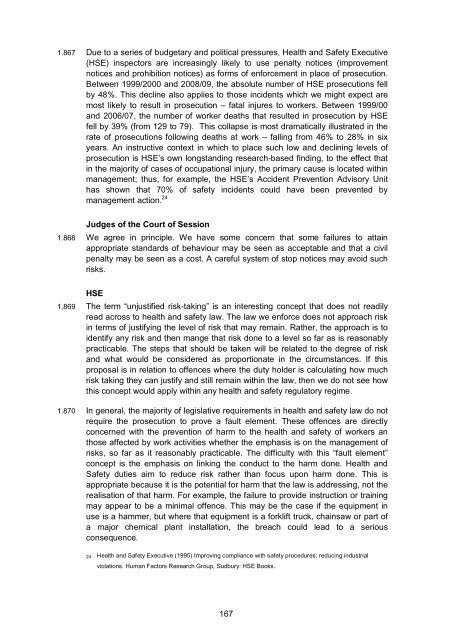Criminal Liability in Regulatory Contexts Responses - Law ...
Criminal Liability in Regulatory Contexts Responses - Law ...
Criminal Liability in Regulatory Contexts Responses - Law ...
Create successful ePaper yourself
Turn your PDF publications into a flip-book with our unique Google optimized e-Paper software.
1.867 Due to a series of budgetary and political pressures, Health and Safety Executive<br />
(HSE) <strong>in</strong>spectors are <strong>in</strong>creas<strong>in</strong>gly likely to use penalty notices (improvement<br />
notices and prohibition notices) as forms of enforcement <strong>in</strong> place of prosecution.<br />
Between 1999/2000 and 2008/09, the absolute number of HSE prosecutions fell<br />
by 48%. This decl<strong>in</strong>e also applies to those <strong>in</strong>cidents which we might expect are<br />
most likely to result <strong>in</strong> prosecution – fatal <strong>in</strong>jures to workers. Between 1999/00<br />
and 2006/07, the number of worker deaths that resulted <strong>in</strong> prosecution by HSE<br />
fell by 39% (from 129 to 79). This collapse is most dramatically illustrated <strong>in</strong> the<br />
rate of prosecutions follow<strong>in</strong>g deaths at work – fall<strong>in</strong>g from 46% to 28% <strong>in</strong> six<br />
years. An <strong>in</strong>structive context <strong>in</strong> which to place such low and decl<strong>in</strong><strong>in</strong>g levels of<br />
prosecution is HSE’s own longstand<strong>in</strong>g research-based f<strong>in</strong>d<strong>in</strong>g, to the effect that<br />
<strong>in</strong> the majority of cases of occupational <strong>in</strong>jury, the primary cause is located with<strong>in</strong><br />
management; thus, for example, the HSE’s Accident Prevention Advisory Unit<br />
has shown that 70% of safety <strong>in</strong>cidents could have been prevented by<br />
management action. 24<br />
Judges of the Court of Session<br />
1.868 We agree <strong>in</strong> pr<strong>in</strong>ciple. We have some concern that some failures to atta<strong>in</strong><br />
appropriate standards of behaviour may be seen as acceptable and that a civil<br />
penalty may be seen as a cost. A careful system of stop notices may avoid such<br />
risks.<br />
HSE<br />
1.869 The term “unjustified risk-tak<strong>in</strong>g” is an <strong>in</strong>terest<strong>in</strong>g concept that does not readily<br />
read across to health and safety law. The law we enforce does not approach risk<br />
<strong>in</strong> terms of justify<strong>in</strong>g the level of risk that may rema<strong>in</strong>. Rather, the approach is to<br />
identify any risk and then mange that risk done to a level so far as is reasonably<br />
practicable. The steps that should be taken will be related to the degree of risk<br />
and what would be considered as proportionate <strong>in</strong> the circumstances. If this<br />
proposal is <strong>in</strong> relation to offences where the duty holder is calculat<strong>in</strong>g how much<br />
risk tak<strong>in</strong>g they can justify and still rema<strong>in</strong> with<strong>in</strong> the law, then we do not see how<br />
this concept would apply with<strong>in</strong> any health and safety regulatory regime.<br />
1.870 In general, the majority of legislative requirements <strong>in</strong> health and safety law do not<br />
require the prosecution to prove a fault element. These offences are directly<br />
concerned with the prevention of harm to the health and safety of workers an<br />
those affected by work activities whether the emphasis is on the management of<br />
risks, so far as it reasonably practicable. The difficulty with this “fault element”<br />
concept is the emphasis on l<strong>in</strong>k<strong>in</strong>g the conduct to the harm done. Health and<br />
Safety duties aim to reduce risk rather than focus upon harm done. This is<br />
appropriate because it is the potential for harm that the law is address<strong>in</strong>g, not the<br />
realisation of that harm. For example, the failure to provide <strong>in</strong>struction or tra<strong>in</strong><strong>in</strong>g<br />
may appear to be a m<strong>in</strong>imal offence. This may be the case if the equipment <strong>in</strong><br />
use is a hammer, but where that equipment is a forklift truck, cha<strong>in</strong>saw or part of<br />
a major chemical plant <strong>in</strong>stallation, the breach could lead to a serious<br />
consequence.<br />
24 Health and Safety Executive (1995) Improv<strong>in</strong>g compliance with safety procedures: reduc<strong>in</strong>g <strong>in</strong>dustrial<br />
violations. Human Factors Research Group, Sudbury: HSE Books.<br />
167
















